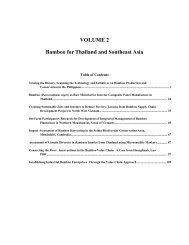WBC-VIII-Vol.4 – Resources – Forestry, Plantations and ... - BambuSC
WBC-VIII-Vol.4 – Resources – Forestry, Plantations and ... - BambuSC
WBC-VIII-Vol.4 – Resources – Forestry, Plantations and ... - BambuSC
Create successful ePaper yourself
Turn your PDF publications into a flip-book with our unique Google optimized e-Paper software.
Research Site <strong>and</strong> Method<br />
Research is continuing at the riparian bamboo forest along Echi River, which is one of the main rivers in the<br />
east-coast plain of Lake Biwa, Shiga Prefecture, Japan. In 1990, the physiognomy survey between the middle<br />
part <strong>and</strong> lower part of river was carried out as the first step, <strong>and</strong> the change of l<strong>and</strong> use <strong>and</strong> vegetation for about<br />
100 years was traced using the topographical maps <strong>and</strong> aerial photographs (Yoshida et. al 1991). According to<br />
the results of this survey, four research sites were set. Vegetation research was started in 1992. Here, mainly,<br />
the results of one research site, which is located in the P. bambusoides forests sparsely mixed with broad-leaved<br />
trees, was analyzed.<br />
Research site locates on the right bank of Echi River, 8 km upstream from the mouth. One quadrat of 40m*40m<br />
was set up. On this site, whole area was used for the research of tree species <strong>and</strong> a half of the area (20m*40m)<br />
was used for P. bambusoides. The research was executed in the fall of 1992 <strong>and</strong> 1994, <strong>and</strong> in the spring of<br />
1997, 1999, 2001, 2003, 2005 <strong>and</strong> 2007. Species name, location, <strong>and</strong> diameter at breast height (d.b.h.) were<br />
surveyed for tree species, <strong>and</strong> location <strong>and</strong> d.b.h. for P. bambusoides.<br />
Results<br />
Physiognomy Survey of Vegetation along Echi River<br />
The occurrence of P. bambusoides along Echi River was frequent as a whole, <strong>and</strong> the rate of occurrence in 1990<br />
was 70% (Table 1). A lot of deciduous tree species belonging to Ulmaceae <strong>and</strong> Fagaceae, which are very<br />
popular as the component of riparian forest vegetation, appeared. As a common forest physiognomy, P.<br />
bambusoides with Celtis sinensis, Aphananthe aspera <strong>and</strong> Zelkova serrata occupy the canopy layer, <strong>and</strong><br />
evergreen broad-leaved tree species, like Quercus glauca, appear as a component of the middle <strong>and</strong> shrub layer.<br />
Nevertheless Pinus densiflora is presumed to have occupied large area, it is decreasing their population because<br />
of pine wilt disease. This presumption was supported by the appearance of many dead pine trees. Cryptomeria<br />
japonica also appeared comparatively in high frequency as plantation. All the individuals of this species are<br />
inferred to be planted just after the flowering of P. bambusoides aiming the change of l<strong>and</strong> use.<br />
Vegetation Transition before <strong>and</strong> after the Flowering of P. bambusoides<br />
Using two aerial photographs, taken before <strong>and</strong> after the bamboo flowering (1961 <strong>and</strong> 1982), the comparison of<br />
vegetation was carried out. The year of 1961 <strong>and</strong> 1982 are about ten years before <strong>and</strong> after bamboo flowering,<br />
respectively. The decrease of P. bambusoides crown caused by the flowering obviously promoted the expansion<br />
of the crowns of tree species. P. bambusoides forests took at least ten years to recover enough crowns after<br />
flowering. It means that, during the recovery process of bamboo forest, the seedlings <strong>and</strong> saplings of tree<br />
species on the forest floor get a chance to grow up without any suppression of bamboo.<br />
The rate of expansion of tree species was compared using the change of crown density <strong>and</strong> occupied area of tree<br />
crown (Table 2). The result shows that they increased 450% <strong>and</strong> 400% in maximum, respectively.<br />
<strong>VIII</strong> World Bamboo Congress Proceedings Vol 4-140




